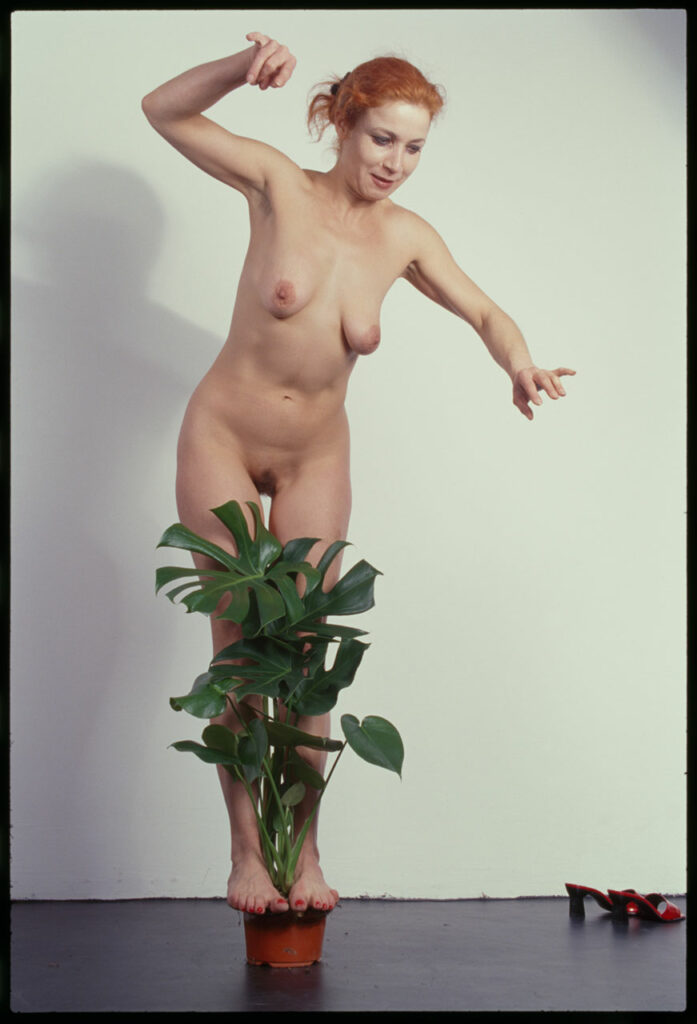I have been dating zher since I was twenty. In the four decades of our relationship, we have shared both domestic sphere and professional environment. We can contribute to the current debate on gender issues and ways of loving as a polyamorous couple in an open relationship. Deliciosa is many in zherself, that is zher nature. The current one is no longer the first and I don’t know how many were before.

For a few years we lost contact and interest in each other. Since the beginning of the year zhe is back, three of zher kind are flocking around me. zher ageless attractiveness has an unbroken effect. Zhe opens zher heart-shaped leaves to me. I remain faithful to zher with devotion.
Deliciosa was already an influencer when Instagram was not even a thought. In the 60s, zhe was preferably relegated to the sideboard in the purist ambience of constructivist living landscapes. Zhe gave shape to the tamed longing for nature in a bourgeois ambience, many-limbed and of unquenchable growth, zher heart-shaped foliage the promise of boundless sensuality, enslaved in the planter like the animal in the zoo.

The philosophers of the Frankfurt School recognised in the houseplant the ‘desideratum of nature as the lifeblood of right-wing radicalism’ and so zher window leaf greened as a natural decorative element on the kidney table between ‘bourgeois subjects as potentially fascist individuals’1.
Zher gestalt was veiled by the cigarette smoke of the 1960s, its foliage shrouded in the ‘scent of the big wide world’: photosynthesis versus Peter Styuvesant.2
Take a breath, open the window.
With zher aerial roots, zhe, the stolen one, claimed freedom and mocked the hymn of Heimaterde – Mutterboden – Vaterland.
Zhe cast zher shadow in psychedelic forms over wood panelling and ornamental wallpaper. Zhe was the V-Jane4 when the lava lamps glowed and from record players in amorphous forms the sounds of ecstasy called for an LSD trip into the next galaxy:
freedom’s just another word for nothing left to loose.

The peasant triangular scarf had long since advanced from headgear to political accessory, and zher leaf adorned boho-chic headbands.
Zhe flirted coquettishly with the art lovers who posed in the Panton chair. Zhe was greening up in the glow of the Anne Jacobs floor lamp. Zhe had made it. Zher forms have become a symbol: Zher leaf fan is a motif on wallpaper, laptop bags and shower curtains, zher heart hand is appliquéd on sofa cushions, a Monstera app can be downloaded from the Apple store and zhe adorns spectacle cases at Rossmann drugstore.
Monstera Deliciosa is the green icon of home decor and part of the Ikea range.

The seed of the South American hemiepiphyte, which bears the indigenous name Piñanona, was brought to the Botanical State Collection in Munich in 1832 by Wilhelm Friedrich von Karwinsky as plant booty from Mexico. Zhe had already been discovered in 1863 by the French botanist Charles Plumier on a research trip to Martinique on behalf of Louis XIV, and Josef Ritter von Warszewicz came across it in Guatemala in 1846. The discoverer accompanied a delegation of the Compagnie Belge de Colonisation, founded in Belgium in 1843, driven by the urge to found a colony in Guatemala.3
In addition to the colonial-scientific name Monstera (monstrum, Latin for miraculous creature, monster), in Spain and Portugal zhe is called Costilla de Adán, or Costela-de-adão, Adam’s rib. In France, England and Switzerland, they call zher Plante Gruyère or Emmental Cheese Plant and zhe has to endure comparisons with holes in cheese. On lion paws, Zampa di Leone, zhe wanders through Sicily. Today zher nationality is mostly considered Dutch. Zher trade routes remain labyrinthine, lost in the thicket of international plant consortia. Zher hip green is the non-certified decorative element to fairtrade coffee and eco-textile shirts. Zhe owes zher beauty to pesticides.
Zher nature is a pretense. Zhe leaves zher Co2 leafprint on bedsheets and adorns fingernails with a colonial tattoo.

I call zher Hysteria Deliciosa. Laying my cheek on one of her leaves, the dark green cools my feverish arousal. I collect her tears. Every weekday I choose a different leaf for a kiss. When I penetrate zher, zhe is the place that holds me, embosoms me. With zher fruits zhe can nourish me. Zher window leaves give me a view.
I live in zher.

Quellen
- Fritz Bühler (Grafiker) – Wikipedia / Peter Stuyvesant (Zigarettenmarke) – Wikipedia
- Bürgerliche Natursehnsucht und faschistisches Potenzial: Theodor W. Adorno, Max Horkheimer und Leo Löwenthal über das Desiderat Natur als Lebensnerv des Rechtsradikalismus
- 15 Surprising Monstera Deliciosa Facts
- VJ / VJane
